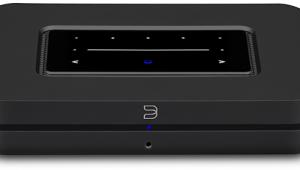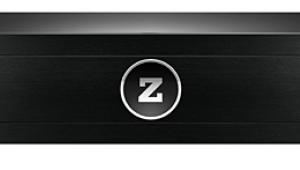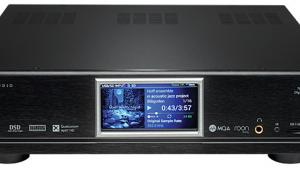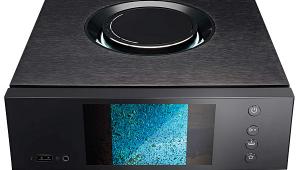Dual-Core Is Hard-Core!
One wife, two kids, and one cat later, it hit me: There are just not enough hours in the day. My leisure hours, like work, have become a matter of multitasking—watching a DVD in one window as I write a review in the other, downloading photos, and sending e-mails. I can no longer use the "I'm already busy" excuse since, frankly, I'm expected to walk and chew gum at the same time around here. And what of my poor PC, which is charged with performing all of the above and more? At least I know I'm not alone, here at wit's end, as the fundamental usage model has evolved and one-thing-at-a-timers have gone the way of the Timex Sinclair.
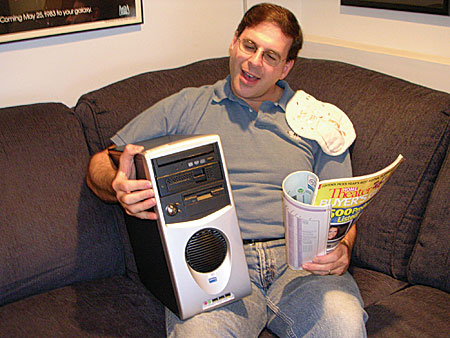
Intel is doing their part by developing new processor technologies with progressive features. And the changes don't just concern the CPU, the computer's digital brain. They also encompass the connecting chipsets and the compact MicroBTX motherboard itself, where the CPU and various other components plug in. Traditionally, higher-end PC solutions have required add-on audio and video cards in order to deliver a worthy home theater–like experience, but no longer. Integrated graphics processing now rivals the performance of some formidable cards, while integrated audio easily supports 5.1 channels or more.
The Baby Behemoth
Imagine my glee when the postman shoved a box through my mail slot, containing a specially built PC from Intel designed to showcase the abilities of a midlevel configuration of their latest platform. This was not a final, consumer-available product for review, and so this story will veer from my usual column. The platform in question is Intel's particular combination of machinery and tweaks, which combine to offer the user some significant new benefits, shifting to incorporate multicore architectures, wherein two or more "execution cores" or computational engines are combined within a single processor. It plugs into a single processor socket, but the system behaves as if it has at least two discrete processors at its disposal. Sharing the load in this manner allows the processor to do more in the same amount of time. This subsequently leads to enhanced performance, reduced power consumption, and more efficient simultaneous processing of disparate duties, improving the end user's experience. In the simplest terms, it offers the power to do more tasks at once on the same PC.

Software—applications and operating systems—is now being written specially to distribute these machines' requisite workloads across multiple cores, a functionality called threading. The supporting processor can execute several threads of code simultaneously. Intel is actively involved here, and the Windows XP Media Center Edition 2005 operating system that arrived on my demo PC, for example, is already optimized for multicore threading. Processor-intensive multimedia applications benefit especially, because their threads can often run in parallel, as do different users accessing the PC for high-bandwidth activities. The trick to ideal multicore exploitation is for applications to split their workloads into multiple "threads," so the virtual brains in the CPU can chew on separate tasks concurrently. Video encoding could split the stream into two threads and encode in parallel for faster results, while games can put actual gameplay on one thread and voice-over IP with a competitor on another thread, allowing you to render the game world more reliably. Again, optimized software needs to be written for multicore and will likely make a splash in the next year or so.
This is not to be confused with Hyper-Threading, which weaves together multiple threads run on a single-core processor: Hyper-Threading is certainly more efficient than non-hyperthreaded processors, but multicore design further increases total computer throughput by virtue of its two or more sets of execution cores. Intel's Extreme Edition processors (snowboarders seem to prefer this option) hyperthread the cores, too, and enable as many as four cores on a single processor for maximum performance. (The Intel Pentium D processor inside of my demo box had two cores.)

The many nagging automatic programs that bogged down boot up were now child's play, and processor-intensive programs did not slow my system as frequently or severely as on my old single-core PC. I could download video, run a couple of different applications—word processing, e-mail, spreadsheets—with lots of files open, all while playing a demanding game like Doom 3. I endured none of those buzz-killing, stress-inducing slowdowns or actual freezes. Choppy screens and audio anomalies were virtually nonexistent. Dual-core is also a blessing to such chores as content creation: recording a TV show with a DVR application or transcoding a large stored file.
What Else Makes It Home Theater Friendly?
Merely cranking up the speeds on the current generation of CPUs would yield minimal additional performance while generating much more heat, which remains a concern for all processors. Intel Precision Cooling Technology automatically adjusts system fan speed in real time, based on the internal chassis temperature at any given moment. When feasible, fans operate at lower speeds, more quietly, and using less power. The CPU assembly has an active heatsink with its own fan, while the chipset heatsink is passive/fanless. Computer cases like the one housing my Pentium D machine are designed with front-panel grilles to help manage those BTUs. Intel also incorporates their SpeedStep tweaks in top-end Pentium processors, enabling them to save still more power and eschew even more heat. So, cooler and less noisy, Intel's technology can fit inside an A/V-like chassis and offer the all-important 10-foot user interface thanks to Windows Media Center Edition and other applications.
Guidelines continue to be developed, with input from Intel on the interoperability of PCs and CEs to make possible marvels like connecting a DVD player or HDTV to your PC for new levels of content streaming. And their latest motherboards with PCI Express slots and the latest processors installed allow seamless integration with all of the accessories you would want on your entertainment computer: a picture-in-picture TV tuner card and more. Intel Audio Studio, available on higher-end models, combines Intel High Definition Audio hardware's 24-bit processing with Sonic Focus audio-refinement software to perform some downright home theater–esque feats. It spreads MP3s to 7.1, providing full control over room settings (width, depth, and ambiance), and it has adjustable noise cancellation, bass management, jack sensing that automatically configures most ports, and even the ability to create a virtual center channel.
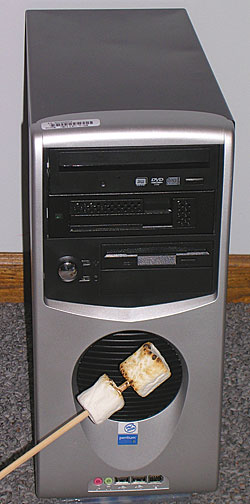 And the capabilities of the GMA 950 in-chipset graphics engine deliver a warm embrace for the HDTV crowd, ready to render 480i, 480p, 576i, 576p, 720i, 720p, 1080i, and 1080p resolutions at 16:9 and 16:10 aspect ratios, with a maximum resolution of 2,048 by 1,536 at 75 hertz. You can customize settings for any type of display device, and a hot plug automatically detects a newly connected display while the PC is operating.
And the capabilities of the GMA 950 in-chipset graphics engine deliver a warm embrace for the HDTV crowd, ready to render 480i, 480p, 576i, 576p, 720i, 720p, 1080i, and 1080p resolutions at 16:9 and 16:10 aspect ratios, with a maximum resolution of 2,048 by 1,536 at 75 hertz. You can customize settings for any type of display device, and a hot plug automatically detects a newly connected display while the PC is operating.
GMA 950 is powerful enough to decode two HDTV streams at once, with hardware-based motion compensation to enhance playback of high-bit-rate MPEG-2 content, too. It can also upscale or downscale video on the fly. Optional Intel Media Expansion or Advanced Digital Display 2 (ADD2) cards can provide TV-out and PVR functionality, or even feed dual displays. Here again, onboard graphics engines such as the GMA 950 require less power than add-in solutions and have a nice, quiet passive heatsink. The MicroBTX motherboards have 3-gigabyte-per-second serial-ATA ports for shorter system-response times. They're tricked out with Intel Matrix Storage technology, which provides quicker access to stored content, faster boots, and protection against hard-disk failure—along with three-drive RAID 5 (Redundant Array of Independent Disks). It's similar to RAID 1 but offers higher capacity to safeguard more digital photos, e-mail archives, music, and movies from loss.
Spending even a few weeks with the Intel demo box hinted at its vast potential, what it can do, and, more importantly, what I could do with it. I could customize both the hardware and software to suit my every need, and seemingly endless usages were the result.


